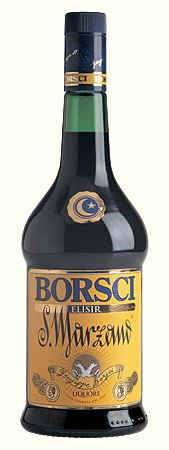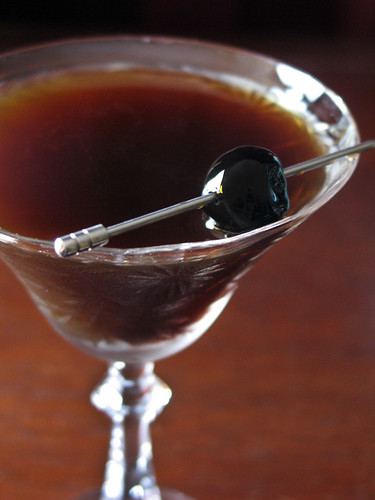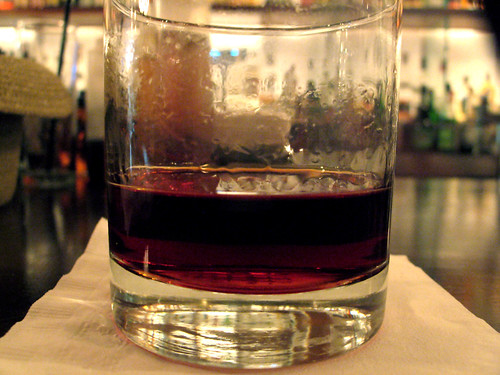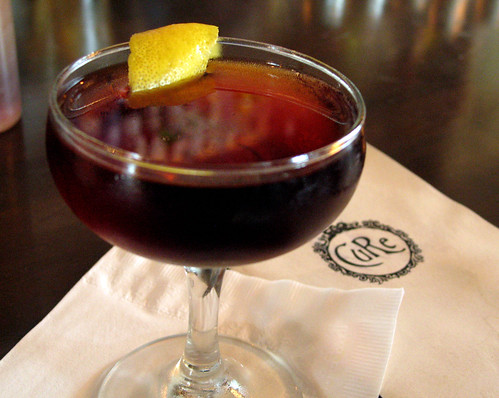Greetings, felicitations and welcome to MxMo 39! Entries are beginning to trickle in, and I expect a veritable flood of them as the day goes on. Besides posting your entry on your own blog, please post a comment to this topic (and as a backup, email me at mr.sazerac at gmail dot com), and please try to do so by midnight tonight — well, at least in your time zone. I won’t start doing the roundup until tomorrow, and I hope to have it up by Wednesday.
 In case you missed the announcement post here or MixologyMonday.com, the theme for this month is amaro — bitter liqueurs generally intended to consume after a meal as a digestive, typical of but certainly not limited to Italy, and the use of those bitters in cocktails. Why did I choose this topic? Because over the last several years I have become an amaro freak.
In case you missed the announcement post here or MixologyMonday.com, the theme for this month is amaro — bitter liqueurs generally intended to consume after a meal as a digestive, typical of but certainly not limited to Italy, and the use of those bitters in cocktails. Why did I choose this topic? Because over the last several years I have become an amaro freak.
It’s been a long journey since 2000, when I took my first sip of Fernet Branca — such a baptism of fire for my first experience with amaro! Sadly, no camera was present to capture the look on my face after taking my first sip, nor was a recorder running to note what was certainly some choice language. In the ensuing years, after samplng more gentle amari and working my way up, I finally had my amaro epiphany, which was the day when I started drinking Fernet Branca not strictly for medicinal purposes after overindulging my tummy, but for pleasure and enjoyment. Now my amaro collection is pretty decent, if I do say so myself (and ripe for expansion): Amaro Abano, Amaro Cora, Amaro Meletti, Amaro Mio Lorenzo Inga, Amaro Montenegro, Amaro Nonino, Amaro Ramazzotti, Amaro di Santa Maria al Monte di Nicola Uignale, Amer Boudreau, Amer Picon Club, Aperol, Averna, Campari, Cynar, Fernet Branca, Gammel Dansk, Jeppson’s Malört, Maraska Pelinkovac, Suze, Torani Amer, Underberg and Zwack Unicum … plus one more which is my most recent acquisition.
 Borsci Elisir San Marzano was one I’d seen passing references to but had never tried until a few bottles showed up at The Wine House, one of my two major spirits emporia and where a significant chunk of my paycheck is deposited every other week. I took it home, poured some into our nice little amaro sipping glasses, and lit up. It’s on the milder end of the amaro spectrum, more hefty than Montenegro, which is my mildest, but one that I thought might be appealing to amaro newbies. The bitter herbs and sweetness are in perfect balance, but there’s a lot more going on in this liqueur — dried fruits, especially figs and plums, touches of chocolate and coffee as well. The liqueur’s been around since 1840, developed in Puglia, Italy by Giuseppe Borsci in the tradition of herbal liqueurs developed by European monks.
Borsci Elisir San Marzano was one I’d seen passing references to but had never tried until a few bottles showed up at The Wine House, one of my two major spirits emporia and where a significant chunk of my paycheck is deposited every other week. I took it home, poured some into our nice little amaro sipping glasses, and lit up. It’s on the milder end of the amaro spectrum, more hefty than Montenegro, which is my mildest, but one that I thought might be appealing to amaro newbies. The bitter herbs and sweetness are in perfect balance, but there’s a lot more going on in this liqueur — dried fruits, especially figs and plums, touches of chocolate and coffee as well. The liqueur’s been around since 1840, developed in Puglia, Italy by Giuseppe Borsci in the tradition of herbal liqueurs developed by European monks.
I looked it up and found interesting recipes on Borsci’s website, although none for cocktails, oddly enough. The first recipe (which I also found in its listing on LeNell’s website was to soak fresh cherries in it, which sounds fantastic. Grapes were recommended for soaking in a simliar fashion, and there was a fascinating procedure for layering almond-stuffed dried figs with chocolate flakes in a jar, then filling with Borsci amaro. There was Borsci tiramisù, Borsci birthday cake, Borsci over strawberries and even over ice cream. All looked good, yet still no cocktails. I seem to have stumbled across my first dessert amaro.
However, it’s recommended chilled or in long drinks as an aperitivo, plus at room temperature as an excellent digestivo, which after several such after-dinner tipplages I can assure you it is, although not as powerfully medicinal as some other amari. After my first sips, though, I started thinking about how I’d use this in a cocktail.
The first thing that came to me was a Manhattan variation. There are several such variations out there that feature various amari (The Red Hook and Little Italy, both favorites, to name two), but it seemed to me that this amaro would work particularly well with a powerful rye base. The hints of chocolate in the this amaro’s flavor base led me to want to pair it with something similar, but by no means did I want this drink to be too sweet, or gods forbid, something desserty. Flavors that would lend itself to an after-meal cocktail, sure, or a lead-in to dessert, but not a “dessert cocktail” per se. Crème de cacao, even the less cloyingly sweet version from Marie Brizard, would be right out, and the only ingredient that seemed right was, oddly enough, something I had never tasted.
Those of us who are bitters fanatics have been waiting with bated breath for the eventual release of the products being developed and produced by the one of the newer cocktail bitters companies, Bittermens. They’d been working on a tantalizing and exciting range of products ranging from “tiki” bitters to hop/grapefruit to pecan bitters, but the one that got my scalp tingling in anticipation was their “Xocolatl Mole” chocolate spice bitters. As they described them: “Inspired by the classic Mexican chocolate mole sauce, this bitters recipe highlights tequila, aged rum and whiskey cocktails. Try substituting these bitters in a Manhattan, or adding to a Margarita.” Holy crapola. I was tremendously excited to hear about this, and disappointed to hear of delay after delay due, oddly enough, not to difficulties vetting them with the TTB, but with local and state health and production permits. And after tasting the Borsci, even though I had never tasted Bittermens Mole Bitters, I knew this was just what my tentative Borsci cocktail needed. (Unless I was completely wrong.)
To add to my frustration, Bittermens sent out a number of samples to bartenders (naturally) and to a few cocktail writers, none of which included me. (Well, other folks to get higher readership, so it made perfect sense.) That didn’t help my writhing jealousy as I read my friend Paul Clarke’s glowing review of his sample of these bitters a year ago January. I was Chartreuse with envy, but knew I just had to wait. Once my taste of Borsci came along, I must confess I grew more impatient — this stuff would go great with Borsci in a cocktail, I just knew it. Bittermens posted periodic updates, and it looked as if we’d finally be able to get our hands on a fully released product a bit later this year … but not in time for my idea for a drink that would be perfect for the MxMo topic I suggested for my turn to host.
Well, all ended well with Wes’ and my long-overdue visit to see all our friends in Seattle in April, and Paul very graciously and generously offered me a small sample from his sample bottle of bitters so I could see if my idea would work. Y’know what? It worked. I’m just a lucky so-and-so … thanks a million, Paul!
I was pretty happy with the drink as I had conceived it, but thought it needed one more little boost, just a tad of Cherry Heering to offer that compementary cherry flavor, I hope without making it too sweet — we get more than enough of that from the amaro itself, and the vermouth. I first tried it with Carpano and while the flavor was good the sweetness was a bit past the line for me. I was much happier with Punt E Mes and its more bitter edge. I also took some advice from bartender Don Lee, who offered this bit of advice regarding another amaro-based drink I was working on — add a tiny pinch of salt. Bingo.
I’m pretty happy with this, and as the Manhattan got to be named after a borough in New York, and as I was lucky enough to get to create a drink named for part of Los Angeles a while back, I wanted to have one named after my own neighborhood.
Use a big rye for this. We’re deeply, madly in love with the bonded 100 proof Rittenhouse rye, which is a fantastic product, priced between $16-18 $21-23 and without a doubt the best rye value on the market. After that try Wild Turkey 101 rye, and we’re even tempted to give this one a go with Thomas Handy.
Since I first came up with this, I’ve become fond of a cherry liqueur that I like better than Cherry Heering in many applications, including this one — Luxardo Morlacco cherry liqueur. It has a purer cherry flavor that for me worked a bit better with the Borsci. Heering will still work as a substitute, though.

The Eagle Rock Cocktail
2 ounces Rittenhouse 100 proof bonded rye whiskey.
1/2 ounce Punt E Mes.
1/2 ounce Amaro Borsci San Marzano.
1 scant barspoon Cherry Heering.
2-3 goodly dashes Bittermens Xocolatl Mole Bitters.
Tiny pinch of salt.
Combine with ice in a mixing glass and stir for 30 seconds. Strain into a chilled cocktail glass and garnish with a Luxardo cherry.
I love one of these after work, and I also liked it after dinner, leading into a big chocolate dessert — I thought it was a lovely transition. Then again, as I write, I’m enjoying one before dinner too. I hope you enjoy it too. If you have a hard time finding Bittermens bitters locally you can mail-order them from a variety of sources; the Google is your friend.
To all the participants in MxMo Amaro, thanks for all your entries so far! We tried a couple last nigiht and got luxuriously toasted. Everyone else, please get your entries posted on your own sites with a comment here by midnight tonight, and I’ll get to work on the roundup.
[N.B. – This post has been revised since its original publication. When this post was first written, Bittermens Xocolatl Mole Bitters hadn’t been released yet, and I was working from a sample. It is now, to the joy of cocktailians everywhere, widely available.]



 In case you missed the
In case you missed the 





